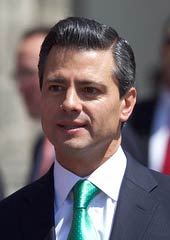Mexico’s Moment
Why is Latin America’s economic spotlight shifting away from Brazil?
March 13, 2013

One thing I didn’t expect to hear on my visit to Mexico was a lot about Brazil. Mexico sees Brazil, as the other large economy in Latin America, as a bit of a rival fighting for its place in the sun.
This not-so-generous sentiment has intensified in Mexico as the world’s attention is making a turn toward to Brazil in the run-up to the FIFA World Cup (in 2014) and the Rio de Janeiro Olympics (in 2016).
The dilemma for Mexicans is simply this: It is hard enough for them even in the best of times to get anybody looking at Mexico City. But it is harder still at this juncture when the entire world, or so it seems, wants to go to Rio.
To be sure, the competition is not just about the World Cup and the Olympic Games. Mexicans also see Brazil as a rival economic model for Latin America.
Mexico remained committed to an open economy, as the country’s strategic promoters argue, even in the face its own “Tequila crisis” of 1994-95 and the global financial crisis of 2008. In contrast, Brazil, they say, has resorted to protectionism, particularly against Mexican industrial goods (especially in the automotive sector).
The prevailing view in Mexico is that their own country, along with Chile, Colombia and Peru, are the good guys in Latin America, committed to openness to trade and foreign investment. As proof, it is offered that Mexico has the largest number of free trade agreements signed in the region, followed by Chile.
In contrast, Brazil leads the camp of the bad guys embracing protectionism, outdone only by Argentina, the baddest guy in the neighborhood in terms of anti-trade policies.
At the same time, there is grudging admiration in Mexico for the success that Brazil’s former President Lula da Silva and his successor Dilma Rousseff have had in fighting poverty in their country. Mexican experts do, of course, claim that this success is based on measures that Brazil copied from Mexico.
But regardless of the merit of these endless comparisons with Brazil, Mexico has had a good story to tell in recent years.
First, there is its macroeconomic story. Over the past decade, with the exception of 2008, when the Lehman Brothers crisis left many countries reeling, economic growth has been in positive territory, most recently clocking in at 3.9% in 2012.
Inflation, too, has been cut in half over the past decade, and the fiscal situation is respectable. The budget deficit amounts to only 2% of GDP, and net public sector debt clocks in at 34% of GDP. That is half of Brazil’s debt level — and one-third the size of the United States’.
Those signs of good housekeeping aside, the first big factor favoring Mexico’s future is the wave of structural reforms being launched by President Enrique Peña Nieto, who took office in December 2012.
Reaching key areas such as taxation, social security, education, pensions and competition policy, these reform measures — although long overdue — are bound to have a significant economic effect. Most specifically, they are expected to lead to a sustainable GDP growth rate of 5% a year going forward. This compares to a rate of only 2% over the past decade.
Second, there is Mexico’s globalization story. Mexico is an open economy, with trade accounting for 60% of GDP. It is favorably connected to two-thirds of the global economy via its arsenal of free-trade agreements (FTAs). As both a Pacific and an Atlantic country, Mexico has strong global economic connections by sea and by air.
Mexico is an enthusiastic supporter of the Trans-Pacific Partnership (TPP) and the Pacific Alliance within Latin America. The TPP countries represent a market of 658 million people and a combined GDP of $20.7 trillion, so it has not surprisingly attracted interest from Mexico.
You can see the globalization of the Mexican economy most clearly by going to Monterrey. According to Rolando Zubiran, the state’s deputy minister for foreign investment, 80% of U.S.-Mexican economic activity passes through Monterrey, with its two railroad lines, large automotive sector, healthcare sector and 127 industrial parks.
“Our aspiration is to be the “Bangalore of Mexico,'” he explains. There are strong links between Monterrey and the Asia-Pacific too, including with Australia.
Finally, there is Mexico’s “demographic dividend.” The average age of Mexico’s population is 26 years. That gives the country an enormous supply of human capital hungry for skills and education.
Seeing Rolando Zubiran, the young dynamic state official in Monterrey, strut his stuff with his young team of experts and managers shows how enthusiastic this generation is for Mexico to succeed. The main question is whether Mexico can keep them and if there will be a reverse of the brain drain – as has occurred in the direction of the United States in the past.
Corruption, crime and China
So much for the good news, I hear you say, now tell me the bad news.
The main risks to Mexican economy are institutional. As is made plain in the influential book Why Nations Fail, by Daron Acemoglu of MIT and James A. Robinson of Harvard, Mexican political institutions have been historically weak. This has had long-term negative economic effects on Mexican entrepreneurship, competition policy, property rights and democracy.
The first institutional issue is corruption and the related need for structural reform. President Pena-Nieto is conscious of the need to make a real push for economic and political reform in his first six months of office. This has become apparent in the recent arrest of Elba Esther Gordillo, the president of the Mexican Teachers Union, on charges of corruption.
Far from pursuing a crooked union official, this move points to a big push for education reform, which is at the top of the new administration’s agenda, along with the related issue of labor reform and pensions.
Gabriel Casillas, chief economist of Casa de Bolsa Banorte, believes that pension and payroll tax reform could make a significant impact on Mexico’s economy by encouraging more workers from the informal sector to join the formal labor market.
This would not only have enormous implications for the country’s productivity, boosting bank assets and providing a dividend to the budget with increased direct income taxes. It would also change scores of lives and family career patterns for generations to come.
The second, and related, issue is security. In key towns and regions throughout Mexico, security issues have re-emerged, largely as a direct result of drug-related gang violence. This is frightening foreign investors and, of course, many Mexican citizens themselves.
In Monterrey, Rolando Zubiran, who enthusiastically explains the region’s economic success, argues that social media activism and the ubiquity of communications technology amplify the impact of isolated violent incidents. But he agrees that there is a problem in terms of both perception and reality.
As a result, Mexico will continue to spend a large part of its economic growth dividend on security and public safety.
The third challenge is overall competitiveness and the influence of China. After China joined the World Trade Organization, many of the gains Mexico made with the North American Free Trade Agreement vis-à-vis the United States and Canada were eroded, particularly in the manufacturing sector.
Now, as China’s labor market tightens and that country’s demographics have begun to work against it (“getting old before you get rich”), it is expected that China’s wage rates will surpass Mexico’s (aside from productivity issues that are notoriously difficult to measure and compare).
The China factor in the Mexican equation brings us back to the Brazil-Mexico rivalry.
Dr. Alfonso Guerra, a distinguished international official at the Bank of Mexico, told me an anecdote that epitomizes the rivalry. Told by a Brazilian official that “Mexicans are not Latin American, they are North American. They all speak English and 80% of their exports go to the United States,” a Mexican official reportedly replied: “Well, then you Brazilians should speak Chinese if you look at your current account.”
Nevertheless, Mexicans do have some reason to be wary of Brazil’s increasing global profile, quite apart from hosting such signature events as the 2014 World Cup and the 2016 Olympics.
After all, what was the last Latin American nation to host both the World Cup and Olympics in such a short span of years? It was Mexico — in 1968 and 1970.
That was Mexico’s moment. And with Brazil standing in the sporting world’s spotlight in 2014 and 2016, Mexico hopes it will be its economic attributes that will attract the world’s attention in years to come.
Takeaways
The main risks to Mexico's economy are institutional, with long-standing negative effects on entrepreneurship, competition policy, property rights and democracy.
In Mexico's eyes, the good guys committed to solid economic principles in Latin America are Mexico, Chile, Colombia and Peru.
Brazil is viewed as leading the camp of Latin America's anti-trade, anti-openness "bad guys" - outdone only by Argentina.
Mexico's net public sector debt amounts to only 34% of GDP. That is half of Brazil's debt level — and one-third the level in the United States.
Mexico has a young and well-trained generation of enthusiastic experts and managers that is eager for Mexico to succeed.

